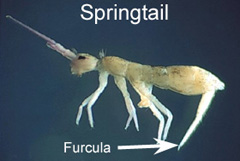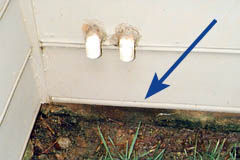 Springtails
are small soil-inhabiting insects. They
occasionally enter homes, particularly
during periods of hot, dry weather.
Springtails are typically
1/6
to
1/5
inch long and wingless. The most common
species in our area are whitish-gray to
brown color, although you can find
species that are lavender-red or
metallic blue in color. They get their
name from the ability to catapult
themselves through the air by means of a
forked tail-like structured called a
furcula (see image at right), which is
attached on the underside of the
abdomen. The ability to "leap" in the
air often leads people to assume that
these are small fleas.
Springtails
are small soil-inhabiting insects. They
occasionally enter homes, particularly
during periods of hot, dry weather.
Springtails are typically
1/6
to
1/5
inch long and wingless. The most common
species in our area are whitish-gray to
brown color, although you can find
species that are lavender-red or
metallic blue in color. They get their
name from the ability to catapult
themselves through the air by means of a
forked tail-like structured called a
furcula (see image at right), which is
attached on the underside of the
abdomen. The ability to "leap" in the
air often leads people to assume that
these are small fleas.
Life Cycle and Habits
 Springtails
can be found almost everywhere outdoors.
They live primarily in the soil, in leaf
mold, organic mulches, under tree bark,
in decaying logs, and may even infest
potted plants. They are most abundant in
damp or moist areas. Some species are
found outdoors in the winter on
snow-covered surfaces and are called
"snow fleas". Springtails play an
important ecological role as
decomposers. They also feed on algae and
fungi and a few species may damage
commercial mushrooms and seedlings in
hotbeds and greenhouses.
Springtails
can be found almost everywhere outdoors.
They live primarily in the soil, in leaf
mold, organic mulches, under tree bark,
in decaying logs, and may even infest
potted plants. They are most abundant in
damp or moist areas. Some species are
found outdoors in the winter on
snow-covered surfaces and are called
"snow fleas". Springtails play an
important ecological role as
decomposers. They also feed on algae and
fungi and a few species may damage
commercial mushrooms and seedlings in
hotbeds and greenhouses.
As the soil/mulch dry out during
prolonged periods of dry weather, the
insects will move. They may be found
congregating near any source of
moisture, such as air conditioner
condensate lines, lawn sprinkler heads,
etc. They will be seen in large numbers
that give a soot-like appearance on
walls, floors, driveways, etc.
Eventually, they make their way indoors.
The most common areas where they're
being found are your obvious sources of
moisture, such as around exterior doors
and windows, in sinks, bathtubs and
around commodes. In many cases,
springtails may be so numerous around
sinks and tubs that people assume that
the insects are coming out of the
drains. Springtails may also enter the
living areas of a home from the
crawlspace. The insects are often
reported in and around new commercial
and residential construction, possibly
because they were brought in with
freshly spread topsoil and mulch. In
some cases, springtails may crawl onto
construction materials stacked at a job
site and may be accidentally "built in"
to a house under construction.
However, when construction is completed
and humidity levels drop indoors, the
springtails should die off.
